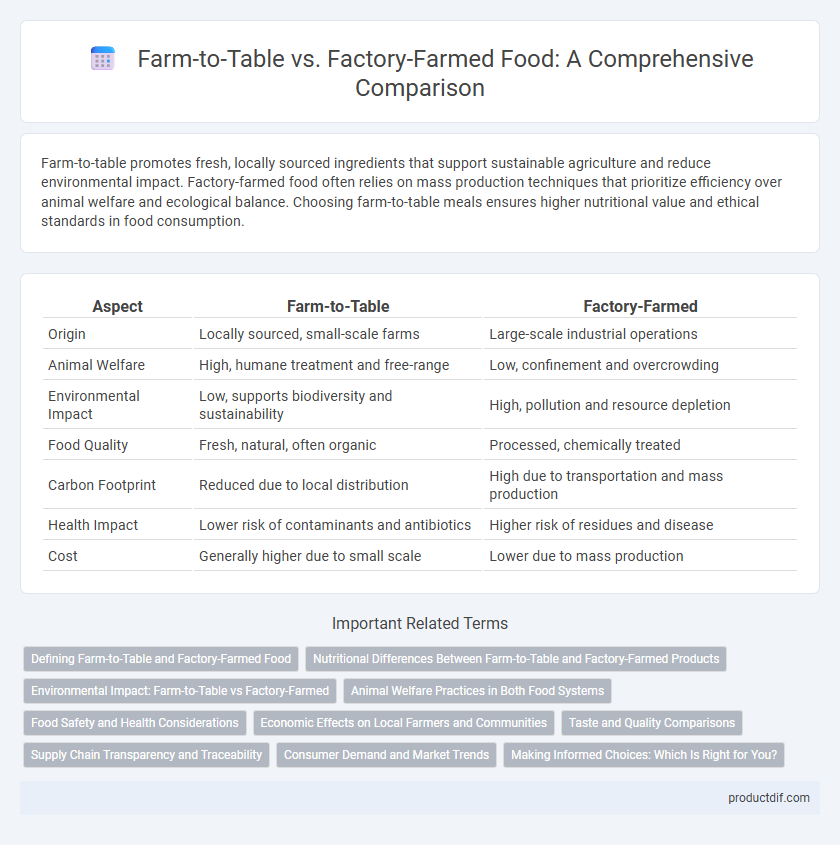Farm-to-table promotes fresh, locally sourced ingredients that support sustainable agriculture and reduce environmental impact. Factory-farmed food often relies on mass production techniques that prioritize efficiency over animal welfare and ecological balance. Choosing farm-to-table meals ensures higher nutritional value and ethical standards in food consumption.
Table of Comparison
| Aspect | Farm-to-Table | Factory-Farmed |
|---|---|---|
| Origin | Locally sourced, small-scale farms | Large-scale industrial operations |
| Animal Welfare | High, humane treatment and free-range | Low, confinement and overcrowding |
| Environmental Impact | Low, supports biodiversity and sustainability | High, pollution and resource depletion |
| Food Quality | Fresh, natural, often organic | Processed, chemically treated |
| Carbon Footprint | Reduced due to local distribution | High due to transportation and mass production |
| Health Impact | Lower risk of contaminants and antibiotics | Higher risk of residues and disease |
| Cost | Generally higher due to small scale | Lower due to mass production |
Defining Farm-to-Table and Factory-Farmed Food
Farm-to-table food refers to products sourced directly from local farms, emphasizing fresh, seasonal, and minimally processed ingredients that support sustainable agriculture and reduce environmental impact. Factory-farmed food is produced in large-scale industrial operations prioritizing high volume and efficiency, often involving confined animal feeding, synthetic inputs, and reduced biodiversity. Understanding these definitions highlights key contrasts in food quality, ethical considerations, and ecological sustainability between the two systems.
Nutritional Differences Between Farm-to-Table and Factory-Farmed Products
Farm-to-table products often contain higher levels of essential nutrients like vitamins, antioxidants, and omega-3 fatty acids due to fresher harvesting and minimal processing methods. Factory-farmed foods tend to have reduced nutritional value because of longer storage, exposure to chemicals, and reliance on synthetic feeds. Studies consistently show farm-to-table offerings provide superior quality in terms of vitamins A, C, and E, as well as minerals such as zinc and iron.
Environmental Impact: Farm-to-Table vs Factory-Farmed
Farm-to-table practices significantly reduce carbon footprints by minimizing transportation distances and promoting seasonal, local produce, which decreases greenhouse gas emissions compared to factory-farmed operations. Factory-farmed systems rely heavily on intensive resource use, including synthetic fertilizers and large-scale energy consumption, resulting in higher soil degradation, water pollution, and biodiversity loss. Sustainable farm-to-table models support regenerative agriculture techniques that enhance soil health and promote ecological balance, contrasting sharply with the environmental strain caused by industrial livestock and monoculture crop production.
Animal Welfare Practices in Both Food Systems
Farm-to-table food systems prioritize high animal welfare standards, emphasizing humane treatment, access to outdoor environments, and natural behaviors for livestock. Factory-farmed operations often compromise animal welfare by confining animals in intensive, overcrowded conditions with limited mobility and increased stress levels. Sustainable farm-to-table practices promote ethical husbandry and better health outcomes compared to the industrial scale and efficiency-driven factory farming models.
Food Safety and Health Considerations
Farm-to-table food sources prioritize minimal processing and local harvesting, significantly reducing the risk of chemical residues and promoting fresher, nutrient-rich produce. Factory-farmed products often involve extensive antibiotic use and crowded conditions, increasing the potential for bacterial contamination and antibiotic-resistant pathogens. Choosing farm-to-table options supports improved food safety standards and contributes to better overall health outcomes by limiting exposure to harmful additives and promoting sustainable farming practices.
Economic Effects on Local Farmers and Communities
Farm-to-table practices bolster local economies by increasing demand for small-scale, sustainable producers, thereby creating diversified revenue streams and job opportunities within communities. Factory farming often centralizes production, leading to economic consolidation that can marginalize independent farmers and diminish local economic resilience. Supporting farm-to-table systems encourages financial stability and community growth by maintaining local supply chains and reinforcing regional agricultural markets.
Taste and Quality Comparisons
Farm-to-table produce often delivers superior taste and quality due to fresher harvesting and reduced transportation time, preserving natural flavors and nutrients. In contrast, factory-farmed foods may lack depth of flavor and have lower nutritional value because of mass production techniques and extended storage periods. Consumers increasingly prefer farm-to-table options for their vibrant taste, ethical sourcing, and high-quality ingredients.
Supply Chain Transparency and Traceability
Farm-to-table food systems prioritize supply chain transparency and traceability by sourcing directly from local farms, enabling consumers to track the origin and production practices of their food. In contrast, factory-farmed products often involve complex, opaque supply chains with limited visibility, making it difficult to verify ethical standards and environmental impact. Enhanced traceability in farm-to-table models reduces risks associated with food safety and supports sustainable agriculture.
Consumer Demand and Market Trends
Consumer demand for farm-to-table products has surged due to increased awareness of sustainability and food quality, driving market trends toward locally sourced, organic produce. Factory-farmed goods still dominate supply chains because of their lower costs and higher volume capacity, but shifting preferences are pressuring retailers to diversify offerings. Market analytics reveal that millennials and Gen Z prioritize transparency and ethical sourcing, influencing growth in farm-to-table restaurant ventures and specialty grocery sections.
Making Informed Choices: Which Is Right for You?
Understanding the differences between farm-to-table and factory-farmed food empowers consumers to make informed choices based on health, environmental impact, and ethical considerations. Farm-to-table foods typically offer fresher, pesticide-free produce and support local economies, while factory-farmed options often provide lower costs and greater availability. Evaluating factors such as nutrient density, carbon footprint, and animal welfare helps determine which approach aligns best with your personal values and lifestyle.
Farm-to-Table vs Factory-Farmed Infographic

 productdif.com
productdif.com